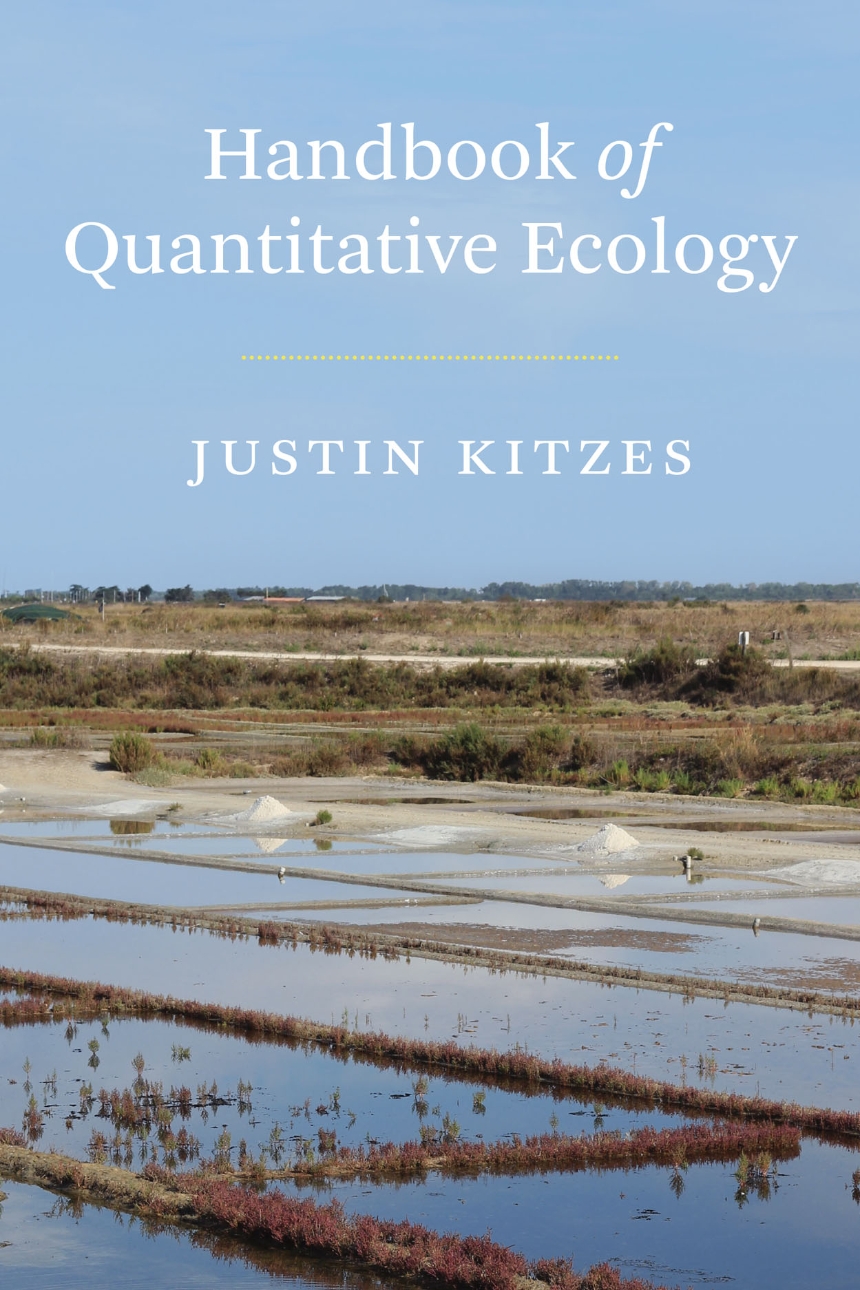Handbook of Quantitative Ecology
An essential guide to quantitative research methods in ecology and conservation biology, accessible for even the most math-averse student or professional.
Quantitative research techniques have become increasingly important in ecology and conservation biology, but the sheer breadth of methods that must be understood—from population modeling and probabilistic thinking to modern statistics, simulation, and data science—and a lack of computational or mathematics training have hindered quantitative literacy in these fields. In this book, ecologist Justin Kitzes addresses those challenges for students and practicing scientists alike.
Requiring only basic algebra and the ability to use a spreadsheet, Handbook of Quantitative Ecology is designed to provide a practical, intuitive, and integrated introduction to widely used quantitative methods. Kitzes builds each chapter around a specific ecological problem and arrives, step by step, at a general principle through the process of solving that problem. Grouped into five broad categories—difference equations, probability, matrix models, likelihood statistics, and other numerical methods—the book introduces basic concepts, starting with exponential and logistic growth, and helps readers to understand the field’s more advanced subjects, such as bootstrapping, stochastic optimization, and cellular automata. Complete with online solutions to all numerical problems, Kitzes’s Handbook of Quantitative Ecology is an ideal coursebook for both undergraduate and graduate students of ecology, as well as a useful and necessary resource for mathematically out-of-practice scientists.
Quantitative research techniques have become increasingly important in ecology and conservation biology, but the sheer breadth of methods that must be understood—from population modeling and probabilistic thinking to modern statistics, simulation, and data science—and a lack of computational or mathematics training have hindered quantitative literacy in these fields. In this book, ecologist Justin Kitzes addresses those challenges for students and practicing scientists alike.
Requiring only basic algebra and the ability to use a spreadsheet, Handbook of Quantitative Ecology is designed to provide a practical, intuitive, and integrated introduction to widely used quantitative methods. Kitzes builds each chapter around a specific ecological problem and arrives, step by step, at a general principle through the process of solving that problem. Grouped into five broad categories—difference equations, probability, matrix models, likelihood statistics, and other numerical methods—the book introduces basic concepts, starting with exponential and logistic growth, and helps readers to understand the field’s more advanced subjects, such as bootstrapping, stochastic optimization, and cellular automata. Complete with online solutions to all numerical problems, Kitzes’s Handbook of Quantitative Ecology is an ideal coursebook for both undergraduate and graduate students of ecology, as well as a useful and necessary resource for mathematically out-of-practice scientists.
176 pages | 24 halftones, 19 tables | 6 x 9 | © 2022
Biological Sciences: Conservation, Ecology, Natural History
Earth Sciences: Environment
Reviews
Table of Contents
Introduction
Part I Change over Time
Chapter 1 Introducing Difference Equations
Chapter 2 Duckweed on a Pond: Exponential Growth
Chapter 3 Throwing Shade I: Logistic Growth
Chapter 4 Throwing Shade II: Lotka-Volterra Competition
Chapter 5 Rabies Removal: SIR Models
Part II Understanding Uncertainty
Chapter 6 Introducing Probability
Chapter 7 A Bird in the Cam I: Single-Variable Probability
Chapter 8 A Bird in the Cam II: Two-Variable Probability
Chapter 9 Picking Ticks: Bayes’s Rule
Chapter 10 Rabbit Rates: Probability Distributions
Part III Modeling Multiple States
Chapter 11 Introducing Matrix Models
Chapter 12 Imagine All the Beetles: Age-Structured Models
Chapter 13 The Road to Succession: Transition Matrices
Chapter 14 A Pair of Populations: Absorption
Chapter 15 Fish Finders: Diffusion
Part IV Explaining Data
Chapter 16 Introducing Statistics
Chapter 17 Seedling Counts I: Maximum Likelihood
Chapter 18 Seedling Counts II: Model Selection
Chapter 19 Flattened Frogs I: Generalized Linear Models
Chapter 20 Flattened Frogs II: Hypothesis Testing
Part V Expanding the Toolbox
Chapter 21 Other Techniques
Chapter 22 Bird Islands: Graphical Thinking
Chapter 23 Max Plant Institute: Optimization
Chapter 24 Bears with Me: Stochastic Simulation
Chapter 25 Natives in the Neighborhood: Cellular Automata
References
Index
Part I Change over Time
Chapter 1 Introducing Difference Equations
Chapter 2 Duckweed on a Pond: Exponential Growth
Chapter 3 Throwing Shade I: Logistic Growth
Chapter 4 Throwing Shade II: Lotka-Volterra Competition
Chapter 5 Rabies Removal: SIR Models
Part II Understanding Uncertainty
Chapter 6 Introducing Probability
Chapter 7 A Bird in the Cam I: Single-Variable Probability
Chapter 8 A Bird in the Cam II: Two-Variable Probability
Chapter 9 Picking Ticks: Bayes’s Rule
Chapter 10 Rabbit Rates: Probability Distributions
Part III Modeling Multiple States
Chapter 11 Introducing Matrix Models
Chapter 12 Imagine All the Beetles: Age-Structured Models
Chapter 13 The Road to Succession: Transition Matrices
Chapter 14 A Pair of Populations: Absorption
Chapter 15 Fish Finders: Diffusion
Part IV Explaining Data
Chapter 16 Introducing Statistics
Chapter 17 Seedling Counts I: Maximum Likelihood
Chapter 18 Seedling Counts II: Model Selection
Chapter 19 Flattened Frogs I: Generalized Linear Models
Chapter 20 Flattened Frogs II: Hypothesis Testing
Part V Expanding the Toolbox
Chapter 21 Other Techniques
Chapter 22 Bird Islands: Graphical Thinking
Chapter 23 Max Plant Institute: Optimization
Chapter 24 Bears with Me: Stochastic Simulation
Chapter 25 Natives in the Neighborhood: Cellular Automata
References
Index
